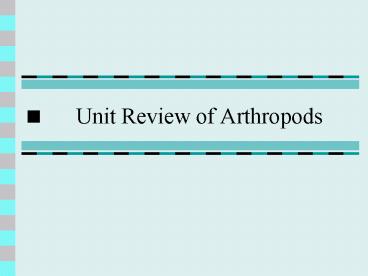Unit Review of Arthropods - PowerPoint PPT Presentation
1 / 39
Title:
Unit Review of Arthropods
Description:
Unit Review of Arthropods – PowerPoint PPT presentation
Number of Views:87
Avg rating:3.0/5.0
Title: Unit Review of Arthropods
1
Unit Review of Arthropods
2
Question 1
- Crustaceans have ______________ pairs of legs.
- 2
- 10
- 5
- 6
3
Question 2
- Arthropods have ____________________.
- 6 legs
- jointed legs
- wings
- 6 pairs of jointed legs
4
Question 3
- Centipedes are ________________
- carnivores
- herbivores
- omnivore
- pollinators
5
Question 4
- Ants and bees are ____________ insects.
- pleasant
- social
- weird
- loving
6
Question 5
- A ___________ looks like a young adult.
- pupa
- nymph
- egg
- larva
7
Question 6
- Egg, nymph and adult are the stages of __________.
- incomplete metamorphosis
- an insects life cycle
- Coleoptera
- complete metamorphosis
8
Question 7
- The most successful phylum of animals on earth
are the _____________________.
- Primates
- Insects
- Diptera
- Arthropods
9
Question 8
- Bees and wasps belong to the class ___________.
- Diptera
- Hymenoptera
- Lepidoptera
- Coleoptera
10
Question 9
- The ladybird beetle feeds on ____________
- nectar
- plants
- cereal
- aphids
11
Question 10
- A compound eyes are made up of _________.
- one lens
- many tiny lenses
- tiny hairs
- 2 elements
12
Question 11
- Beetles belong to the class _____________.
- Diptera
- Hymenoptera
- Lepidoptera
- Coleoptera
13
Question 12
- ____________ keeps the insect from drying out.
- An exoskeleton
- Bone
- Cotton
- Antennae
14
Question 13
- The three parts of an insects leg are
____________.
- femur, tibia and tarsus
- lions, tibia and bears
- ulna, radius and tarsus
- femur, tiger and tarsus
15
Question 14
- A cephalothorax is _____________.
- an enlarged thorax
- an abdomen and thorax combined
- a head and antennae combined
- a head and thorax combined
16
Question 15
- Pheromones are used by insects ______________.
- to make people sneeze
- as a defense mechanism
- as an aggressive mechanism
- to attract other insects
17
Question 16
- Flies and mosquitoes belong to the order
_________.
- Diptera
- Hymenoptera
- Lepidoptera
- Coleoptera
18
Question 17
- _______________ is the study of insects.
- Biology
- Herpetology
- Entomology
- Insectology
19
Question 18
- _____________ have 4 pairs of legs.
- Mosquitos
- Arachnids
- Diplopods
- Dogs
20
Question 19
- Spiracles are located on the __________ of the
grasshopper.
- head
- legs
- thorax
- abdomen
21
Question 20
- Moths spin a __________ when they are in the pupa
stage.
- cocoon
- chrysalis
- case
- web
22
Question 21
- Grasshoppers breath through _________ in their
abdomen.
- ovipositor
- spiracles
- tympanum
- book lungs
23
Question 22
- Insects have _________ pair of antennae on their
heads.
- 2
- 10
- 5
- 1
24
Question 23
- Millipedes are _______________ hunters.
- fast moving
- efficient
- slow moving
- random
25
Question 24
- A camouflage and mimicry are examples of
_________.
- metamorphosis
- chemical control
- learning
- defensive mechanism
26
Question 25
- Bees and butterflies _____________ plants.
- party on
- look like
- destroy
- pollinate
27
Question 26
- Eyes and antennae are located on _______.
- insects head
- your head
- the thorax
- insects mouth
28
Question 27
- Insect lay eggs through their ______________
- ovipositor
- tympanum
- antennae
- jumping legs
29
Question 28
- Two types of eyes are ________________.
- compound and single
- composite and simple
- composite and single
- compound and simple
30
Question 29
- Moths are responsible for _______________.
- causing malaria
- causing sleeping sickness
- night-time pollination.
- day-time pollination
31
Question 30
- An examples of a crustacean is ____________.
- beg bugs and crayfish
- a rollie pollies and lobsters
- centipede and millipedes
- barnacles and wasps
32
Question 31
- Mosquitoes cause diseases such as __________.
- Sleeping Sickness
- Colds
- West Nile
- Plague
33
Question 32
- Mosquitoes have __________________.
- jumping legs
- chewing mouth parts
- wing covers
- piercing mouth parts
34
Question 33
- The use of pesticides is an example of
___________.
- biological control
- pollination
- the scientific method
- chemical control
35
Question 34
- The stages of complete metamorphosis are _______.
- egg, pupa and adult
- egg, larva, pupa and adult
- egg, nymph and adult
- egg, nymph, pupa and adult
36
Question 35
- Insect legs are attached to the insects
___________.
- tympanum
- head
- thorax
- abdomen
37
Question 36
- A ____________ can be described as an eating
machine.
- larva
- mosquito
- apple
- pupa
38
Question 37
- Insects are so successful because ____________.
- they raise their young
- they live only in a few areas
- they have a high birth rate
- they only eat a few types of foods
39
Remember to also study
- Biological Classification
- The Six Steps of the Scientific Method
- External Grasshopper Anatomy































